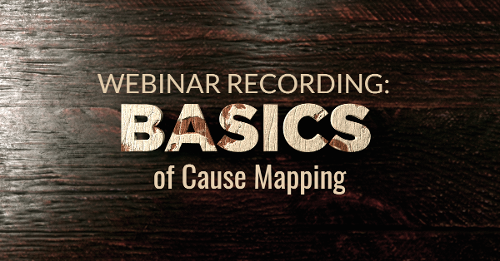Can an incident be too BIG or too SMALL to Cause Map?
The short answer is no, an incident is never too big or too small to Cause Map. Cause Mapping, a scientific approach to root cause analysis, can be used to help solve any problem, from personal, to work related, to “whew, that was close” observations. Cause Mapping is simply documenting cause-and-effect relationships using available evidence to validate each relationship. The fundamental aspects of the approach may be applied to any type or size of problem. We believe that there is value in investigating any and all problems.
Problems come in different sizes, investigations should too
An incident/problem might affect one person, a department within a company, or an entire organization. Organizations typically setup different levels of an investigation depending on the impacts of the problem. For example, a “Level 1” investigation might be for a near miss and the team might only consist of two people: the person who reported the near miss and the facilitator to document the findings. A “Level 2” investigation could be for a reportable spill that required minimal resources to clean up. That team might consist of an interdisciplinary team of 2-4 people including the facilitator. A “Level 3” investigation could be used when a problem costs the organization hundreds of thousands of dollars and affected many people. In most circumstances, the size of your problem will be proportionate to the time spent investigating the problem, the number of people involved and resources put into addressing the issue.
You can use the same tool for all investigations
No matter what size the problem is or the level of investigation it requires, the Cause Mapping Method can be used and the process stays the same. The first step is still to use the Outline to define the problem, a Cause Map is still built to analyze the issue and the final step will be to identify the specific actions that will be taken to reduce the risk of a similar issue from occurring. It’s just the level of involvement and amount of detail that vary. In most circumstances, the size of your problem will be proportionate to the time spent investigating the problem and the number of people involved.
Value in investigating near misses
It’s obvious why you would want to investigate large incidents, but what is the value of a root cause analysis small incidents? In theory, the more small incidents (non-reportables, near-misses, day-to-day issues) you investigate and find solutions for, then the larger incidents are less likely to happen because you have already found solutions to mitigate them. Let’s say an organization’s spill reporting threshold is 42 gallons. It might be a good use of time and resources to conduct an incident investigation for spills that are less than the reporting threshold in order to reduce the risk of a large spill happening.
We can help!
Our goal is to help our clients fully understand each incident, so we can develop solutions to prevent them from happening again in the future. Cause Mapping can be used to troubleshoot day-to-day issues as well as investigate extremely complex problems that require very thorough and clear documentation. ThinkReliability has experience investigating a wide range of problems in many different industries. We can facilitate an incident investigation for a work place fatality, smaller OSHA recordable, or a near miss injury. Contact us to help.
Additional resources:
Review some of the root cause analysis examples on our website and let us know how we can help you with one of your safety incidents. We can review one of your issues for you to compare what you’re doing now with what a complete cause-and-effect analysis looks like. Contact our office for assistance.














